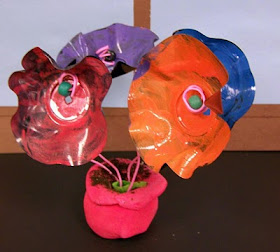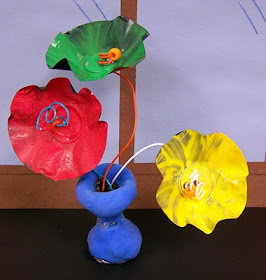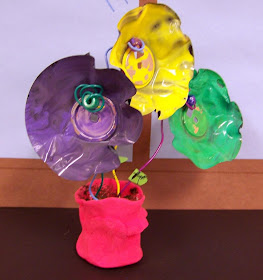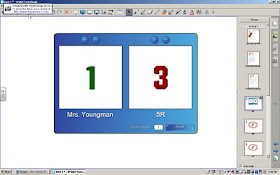-Understand that art can be made out of anything
-Use recycling to create a work of art
TERMS:
-Pinch Pot: Creating a pot out of a pliable material by pinching with the fingers.
MATERIALS:
Floppy Discs
Jazz Paint
Paint Brushes
Newspaper
Water/Water Containers
Toaster Oven/Polymer Clay Oven
Crayola Model Magic in a variety of colors
Twisteez Wire
Pony Beads
Potting Soil
Glue
Green Construction paper
Scissors
Black Sharpies


Next, I showed the children how to create a pinch pot out of Crayola Model Magic. Because it's an Art Show project I didn't show them that they can create a marbled look with two colors, or mix them to get a secondary color. I was going for simplicity so they got to choose red, yellow, blue, or white for their pot. I stressed making sure that their pot would stand before adding wires (although, I still had to add a cardboard base to a few of them). When the pot was shaped, they needed to add a wire for each flower that they painted.

Before the next class, I melted each disk in the toaster oven. I pushed them into the top of a coffee mug and put them in at about 250 degrees; it only took about ten seconds for each one to melt into the form. When the kids came in, I showed them how to create a leaf on a folded piece of paper, so the fold kept them attached. They were asked to glue zero, one, or two leaves to each wire. We wrapped the wire around a pencil to get a "spring" at the top of each wire and twisted one disk onto the wire. I stressed stopping in the middle of the spring so the flower wouldn't fall all the way down. A pony bead was added, and then the spring was squished shut. When all the flowers were added, they added a bit of potting soil on the top of the pot to make it look like the flowers are actually growing. They turned out adorable!


 While introducing this concept to the kids, I started by talking about how they can "help us reach our goal" of beating the bomb. I asked questions like "will standing, and counting down help us reach our goal?" They answered with a resounding NO! "Would checking the floor help us reach our goal?" YES! The first time or two, it was a little loud, but I started walking around, quietly mentioning things like "Ooooh, I see a marker under the red table." They noticed that if they listen while they clean, I will mention everything that needs to be done by the time the bomb explodes. I also made sure that the last item on every clean up list is that they are sitting quietly in their seats. This avoids the while class counting down at the top of their lungs.
While introducing this concept to the kids, I started by talking about how they can "help us reach our goal" of beating the bomb. I asked questions like "will standing, and counting down help us reach our goal?" They answered with a resounding NO! "Would checking the floor help us reach our goal?" YES! The first time or two, it was a little loud, but I started walking around, quietly mentioning things like "Ooooh, I see a marker under the red table." They noticed that if they listen while they clean, I will mention everything that needs to be done by the time the bomb explodes. I also made sure that the last item on every clean up list is that they are sitting quietly in their seats. This avoids the while class counting down at the top of their lungs.  I have a SMART Notebook file for each day, and have the bomb, clean up lists for drawing, painting, and clay which can be moved within the slideshow depending on which materials we are using that day. Then I have a slide for each class' scoreboard. At the end of the day, I hit save and we continue each time the class meets. I told the kids they would get a "mystery prize" at the end of the year if they have more points than I do.
I have a SMART Notebook file for each day, and have the bomb, clean up lists for drawing, painting, and clay which can be moved within the slideshow depending on which materials we are using that day. Then I have a slide for each class' scoreboard. At the end of the day, I hit save and we continue each time the class meets. I told the kids they would get a "mystery prize" at the end of the year if they have more points than I do. 

